Family Name: Boraginaceae Jussieu
Synonym(s): Anchusaceae Vest; Buglossaceae Hoffmanns. & Link, nom. illeg.; Onosmaceae Martinov; Sebestenaceae Vent., nom. illeg.
Common Name(s): borage family
*Number of genera/species: 85/1,600-1,700
List of genera records in GRIN-Global
Fruit a schizocarpschizocarp:
usually dry fruit splitting between two or more locules to form distinct, indehiscent, usually one seeded segments; fruit derived from a single, superior or inferior, compound ovary; compare to mericarp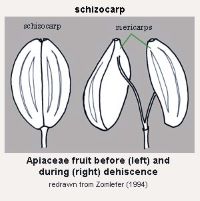 usually separating into four nutletsnutlet:
usually separating into four nutletsnutlet:
˜achene
, sometimes fewer by abortion or fusion, 0.6–5 mm, rarely to 15 mm, discoiddiscoid:
3D shape—resembling a disc
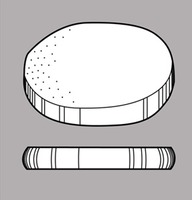 , lens-shapedlens-shaped:
, lens-shapedlens-shaped:
2D shape—round and flattened with two curved (convex) surfaces
, ovoidovoid:
3D shape—ovate , lanceolatelanceolate:
, lanceolatelanceolate:
2D shape—lance-shaped; much longer than wide, with widest point below the middle, tapering to the apex (compare oblanceolate)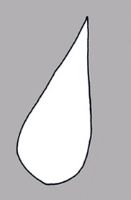 , trigonoustrigonous:
, trigonoustrigonous:
3D shape—having three faces that meet at distinct angles; triangular in outline
, tetrahedral, or bowl-shaped, straight or curvedcurved:
(of embryo) linear embryo is curved into an arch or horseshoe with the ends far apart , tereteterete:
, tereteterete:
approximately circular in cross section; width and thickness approximately equal
 or sometimes laterally compressedcompressed:
or sometimes laterally compressedcompressed:
flattened; in grasses, used to denote compression (not necessarily flattened) either laterally or dorsiventrally
, apexapex:
the point farthest from the point of attachment, or the "tip" of an organ often beakedbeak:
often beakedbeak:
a usually firm, terminal appendage, sometimes tapered , margins often ridged, usually with one seed.
, margins often ridged, usually with one seed.
Pericarppericarp:
fruit wall or fruit coat
black, gray, brown, yellow, or white, usually dulldull:
reflecting only a low proportion of incident light, with no apparent sheen , usually bonybony:
, usually bonybony:
very hard and rather brittle, like bone
, sometimes fleshy or papery, usually glabrousglabrous:
without hairs
, rarely pubescent (Lasiospermum, some Trigonotis spp.), smooth or keeledkeel:
a longitudinal ridge, like the keel of a boat, formed by the lengthwise folding of a structure, such as a lemma or palea
 , papillose, wartywarty:
, papillose, wartywarty:
surface relief—distinct, rounded projections that are large relative to the fruit size; tuberculate, verrucose , wrinkledwrinkled:
, wrinkledwrinkled:
surface relief—shallow, irregular folds and furrows covering the surface; appearing overall though crumpled and then spread out , spinose, with irregular crests, or with complex glochidia (multicellular with one to many hooklike structures, sometimes forming a wing). Fruits often with prominent attachment scars that vary in shape from circularcircular:
, spinose, with irregular crests, or with complex glochidia (multicellular with one to many hooklike structures, sometimes forming a wing). Fruits often with prominent attachment scars that vary in shape from circularcircular:
(of embryo) linear embryo is curved into an "O" shape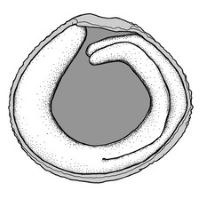 to triangulartriangular:
to triangulartriangular:
2D shape—three relatively straight sides with distinct corners; more angular than teardrop-shaped and in position. A scar sometimes extending the length of the fruit. Fruits sometimes enclosed in calyxcalyx:
and in position. A scar sometimes extending the length of the fruit. Fruits sometimes enclosed in calyxcalyx:
the outer whorl of the perianth; all the sepals of a flower at maturity, if within calyxcalyx:
at maturity, if within calyxcalyx:
the outer whorl of the perianth; all the sepals of a flower usually covered in hooked hairs (Asperugo, some Myosotis spp., Moritizia, Pectocarya) or calyxcalyx:
usually covered in hooked hairs (Asperugo, some Myosotis spp., Moritizia, Pectocarya) or calyxcalyx:
the outer whorl of the perianth; all the sepals of a flower winglike (Suchtelenia).
winglike (Suchtelenia).
Fruits often with peg-shaped tissue derived from prolonged receptacle (gynobasegynobase:
an elongation or enlargement of the receptacle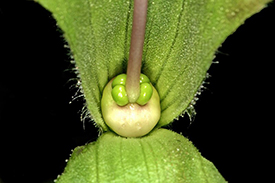 ) breaks off with nutletnutlet:
) breaks off with nutletnutlet:
˜achene
, and in a few genera functions like an elaiosomeelaiosome:
a lipid and protein-rich fleshy structure attached to some seeds and fruits, it attracts ants which then disperse the disseminule (e.g., caruncle in the Euphorbiaceae, the aril (outgrowth of the funiculus) in the Fabaceae)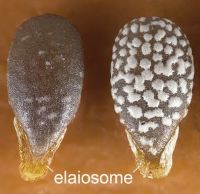 . Fruits sometimes heteromorphic in shape and surface relief.
. Fruits sometimes heteromorphic in shape and surface relief.
Embryo well developed, partially or nearly filling seed cavity, foliatefoliate:
appearing leaf-like
.
Endosperm scanty.
| Fruit | |
| Type | nutletnutlet: ˜achene |
| Size range | 0.6–5 mm long, rarely to 15 mm |
| Shape(s) | discoiddiscoid: 3D shape—resembling a disc  , lens-shapedlens-shaped: , lens-shapedlens-shaped:2D shape—round and flattened with two curved (convex) surfaces , ovoidovoid: 3D shape—ovate  , lanceolatelanceolate: , lanceolatelanceolate:2D shape—lance-shaped; much longer than wide, with widest point below the middle, tapering to the apex (compare oblanceolate)  , trigonoustrigonous: , trigonoustrigonous:3D shape—having three faces that meet at distinct angles; triangular in outline , tetrahedral, bowl-shaped |
| Texture | usually bonybony: very hard and rather brittle, like bone , sometimes fleshy or paperypapery: texture—papyraceous, chartaceous; very thin, pliable, and readily torn; like paper |
| Surface relief | smooth or keeledkeel: a longitudinal ridge, like the keel of a boat, formed by the lengthwise folding of a structure, such as a lemma or palea  , papillosepapillate: , papillosepapillate:surface relief—bearing minute, distinct, broad-based projections, tapering to a rounded apex  , wartywarty: , wartywarty:surface relief—distinct, rounded projections that are large relative to the fruit size; tuberculate, verrucose  , wrinkledwrinkled: , wrinkledwrinkled:surface relief—shallow, irregular folds and furrows covering the surface; appearing overall though crumpled and then spread out  , spinose, with irregular crests or with complex glochidia (multicellular with one to many-hook like structures, sometimes forming a wing) , spinose, with irregular crests or with complex glochidia (multicellular with one to many-hook like structures, sometimes forming a wing) |
| Color(s) | black, gray, brown, yellow, white |
| Unique features | Dulldull: reflecting only a low proportion of incident light, with no apparent sheen  , small, bonybony: , small, bonybony:very hard and rather brittle, like bone one-seeded nutletsnutlet: ˜achene usually with prominent attachment scar and often ornamented surfaces. |
| Other | |
| Embryo | well developed, partially or nearly filling seed cavity, foliate |
| Nutritive tissue | endosperm scanty |
Widely distributed in warm north temperate regions, also tropical and subtropical
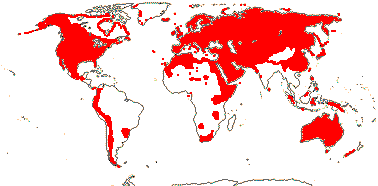
Distribution map courtesy of Angiosperm Phylogeny Website.
Flora of Australia 2021+Flora of Australia 2021+:
Flora of Australia. Australian Biological Resources Study, Canberra. Accessed January 2021–March 2024. URL: http://www.ausflora.org.au; Flora of North America Editorial Committee 1993+Flora of North America Editorial Committee 1993+:
Flora of North America Editorial Committee, eds. 1993+. Flora of North America North of Mexico [Online]. 22+ vols. Flora of North America Association, New York and Oxford. Accessed January-March 2024. URL: http://beta.floranorthamerica.org. (unpublished); Kirkbride et al. 2006Kirkbride et al. 2006:
Kirkbride JH, Jr, Gunn CR, and Dallwitz MJ. 2006. Family guide for fruits and seeds, vers. 1.0. Accessed September 2020-January 2022. URL: https://nt.ars-grin.gov/seedsfruits/keys/frsdfam/index.cfm .; Kubitzki et al. 1990+Kubitzki et al. 1990+:
Kubitzki K et al., eds. 1990+. The families and genera of vascular plants. 7+ vols. Berlin etc.; Nash and Moreno 1981Nash and Moreno 1981:
Nash DL and Moreno NP. 1981. Boraginaceae. Flora de Veracruz. Fasciculo 18. el Instituto National de Investigaciones sobre Recursos Bioticos, Xalapa, Veracruz, Mexico.; Takhtajan 2009Takhtajan 2009:
Takhtajan A. 2009. Flowering plants: Second edition. Springer Nature, Switzerland. 871 pp.; Tutin et al. 1964–1980Tutin et al. 1964–1980:
Tutin TG, Burges NA, Chater AO, Edmondson JR, Heywood VH, Moore DM, Valentine DH, Walters SM, and Webb DA (eds.) 1964–1980. Flora Europaea. 5 vols. Cambridge University Press, Cambridge UK. 2,524 pp.; Zhengyi et al. 2004+Zhengyi et al. 2004+:
Zhengyi W, Raven PH, and Deyuan H. 2004+. Flora of China [online]. 25 vols. Science Press, Beijing China & Missouri Botanical Garden, St. Louis USA. Accessed January–March 2024. http://flora.huh.harvard.edu/china/
*The number of genera and species is based on Kubitzki et al. 1990+Kubitzki et al. 1990+:
Kubitzki K et al., eds. 1990+. The families and genera of vascular plants. 7+ vols. Berlin etc. (see Volume 14 published in 2016), which may differ from the number of genera in GRIN-Global.